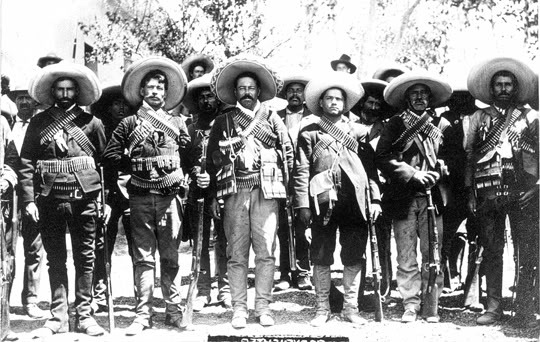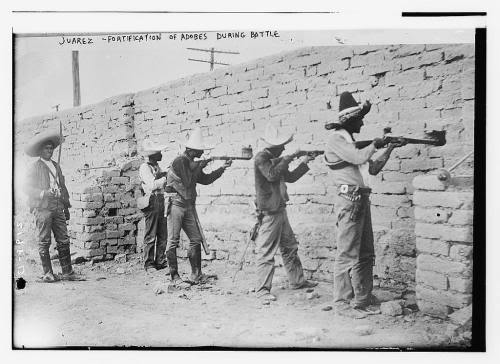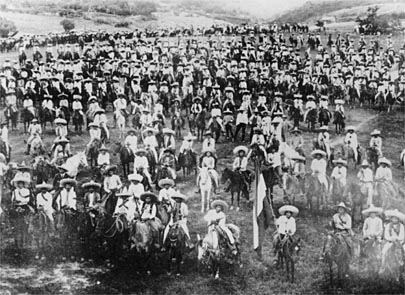This year is the 100th anniversary of the Mexican Revolution, that as we all know was the source of inspiration for several SW that we all love, many Italian (and not only) directors with a political agenda took advantage of the love for western from the public combine with a favourable historical (for cinema scripts I mean) chain of real events during the Mexican revolution, to make the perfect analogies and metaphors in their films with the social revolution lived in several countries throught out the sixties.
What do you know about the Mexican revolution apart from Tomas Millian and Volonte were on it?
In a very simplified and simplistic way I will try to explain the chain of events that made the revolution possible and its results.
The rebellion that started for all effects in 1910 against the long time dictator (for more than 33 years in power until the date) Porfirio Diaz, was first not more than a small wind before it transformed itself in a major storm.
According to Enrique Kraute author of a most brilliant book trilogy about Mexican history and that I quote, were several the causes and Revolutions that hit Mexico in the second decade of the XX century. The 1910 insurrection of Indalecio Madero (not Professor Xantos then) against Diaz opened a historical precedent of changes and transformations that is best know as the Mexican Revolution, in reality the revolution was the sum of conflicts and rebellions of different backgrounds: social and farmers ones, from the outcast native population, religious ones, from the bourgeois… many ones, as numerous as the several Mexico’s that existed at the time, everyone wanted the rebel against something those days.
In any case the revolution curved around two main axis one on the South that was a real uprising of the campesinos (mostly Indians or native people (as you prefer to call it) for land and better conditions of life (they lived in what can be called perfect slavery conditions) and in the North that was more a rebellion of the tierratenentes or landlords many of Indian origin but not all. Both insurrections charged against a way of making politics that was rotten since the time the Mexican state was born back in 1821.
Another constant thing of that decade of revolts and uprisings, was the enormous violence that the country suffered, no one really knows the exact numbers but calculations give a number of more than a million deaths some even go further, and give numbers more closer to two million, so when you all see that body count of Mexicans in Almeria with the Gatling guns and the Hotchkiss shooting around that was no joke in real life I’m afraid.
Other characteristic was the constant involvement and interference from the US (another analogy for SW), not only defending the interests of their citizens in the country and their own in the process, but also cause of a dynamic frontier life.
The ambition for power was constant and violent; the military power and not only was always alert against the main protagonists of the rebellions, that ambition in most of the cases ended up in bloodshed from 10910 to 1929 almost all of Mexico presidents and also the main revolutionary leaders ended up murdered.
The Mexican Revolution started as will to restore to old liberal order against the church and the more immobilise forces as Madero wanted, to derivate into a Social revolution proper of the XX century .

CAUSES
The large presidency of Porfirio Diaz that preside over Mexico as an old Patriarch, with authority in his first time in power (1876 to 1880) and then from 1984 to 1911 was more characterized by a general development well accepted by the country cause it was long blooded by the defeats in the wars with the US and for the constant confrontations and small wars between conservatives and liberals, unionist and federalists. But with this development, justice and more freedom and better living conditions to the indigenous and peasants never arrived.
Diaz got his back covered by the landlords, the church and all those contrary to Liberal reforms also an important group of young technocrats called the “cientificos” (Scientifics). Even though with a very controlled freedom, this was a period where Mexico catch up with the rest of the developed world mainly the new one, and had even a certain economical grow.
But in 1910 the businessmen from the north regions especially from the new iron industry (a resource that Mexico had plenty), confronted the power of the cientificos and their alliance with the foreigner (Europeans and US). By 1910 Mexicans in general had the impression that Diaz had delivered the country resources to the foreign capital, also the new Mexican bourgeoisie (indifferent in general to serious social inequality that the country suffered), was tired of the lack of liberty and the indulgent style of Diaz government, in the end the new educated middle class that the recent years of prosperity created, now wanted themselves to reach the political and economic power. So the answer to that middle class was a man called Francisco Madero a rich landlord from the North that denied the patriarch politic style of Diaz, in 1908 he write a book La sucesion presendicial de 1910, which was a big exit in the literate people that wanted the democratic changes. In response Diaz arrested Madero against the will of the majority fearing that we might win a free election. Doing so he prevented Maderos from participating in the elections.

Diaz won in a fraudulent way the 1910 elections that would allow him to rule until 1916, (by now Diaz was an 84 years old man). But Maderos escaped to the US and from there he pronounce the plan that would unified both the main claims one from the Northern oligarchies and other the devolution of land to the peasants of more importance in the South, and from St Antonio in Texas at the 20th of November 1910 he proclaimed to the Mexican people to up rise and take arms against the regime, in the unique case of a Revolution with an announced hour, as some more ironic people said.
The rebellion was weak in the first moments, but slowly and steadly extend in all the northern states, and in May 1911 took place also in the south (Morelos state) commanded by a campesino named Zapata, los Maderistas conquered the states of Chihuahua, Baja California and Veracruz, Pancho Villa conquered Ciudad Juarez (an most important border city), as a consequence of the military triumph a peace treaty was firmed and new elections Diaz went to exile in Paris, and Madero won the elections in 1911 with 98% of the votes.
He made a few changes but the bases of the Diaz regime remained unmoved, the general administration or public services and the federal Army, he also did not respect the promises made to the Zapatistas in the South to make the agrarian reform, in response Zapata denied to disarm as Madero had demanded (he was against the violence of the expropriations) and so a rupture was produced that converted the triumphant rebellion of 1910 into a revolution with several open conflicts.
In November of 1911 Zapata proclaimed the nationalization of the lands from the landlords. The most insurgent Mexico appeared in the form of Pancho Villa that represented a sort of rural and warrior utopia in the North, and Zapata that commanded the outcast from the South mainly indigenous, the revolutionary wars started at this point.
Maderos a very spiritual men, who believed that he could talk to the dead, believed to be a illuminated convinced that he had been called by divine providence to save Mexico, made the mistake of not getting rid of all Diaz men. He send one those old Diaz men, General Huerta to crush the Zapatistas in the South, and after Huerta return (without really finish his mission, he only made the Zapatistas turn into guerrileros), he started a conspiracy supported by the US to take Maderos out of the power, in 1913 he put his plan into action, also with one of Diaz nephews to back him up, and killed both Maderos and his vice president that even after taking refuge in the US Embassy were detained and killed. This of course brought more war both in North and South, Villa with is now famous North Division took Chihuahua state and Zapata in the South didn’t also recognize the new government and kept his fight.
The death of Maderos turned all Mexico into a bloody battlefield, this period is the best known of the Mexican revolution (and the most used for films I guess) and maybe it’s most violent.
Villa, Zapata and also Carranza who was the governor of Coahuila State and ex Diaz supporter, did not recognized Huerta Government and with the aid of some others state governors, military and US companies (and later from the US government) decided to fight backHuerta, those three together reach several military victors and now had International attention. Huerta after loosing US support cause of his defeats (talk about betting on the wrong horse) surrender to Carranza and is Constitutional Army (as they were called) and run away to Spain where he tried during WWI period, and with tried with the help of the Germans (it was a story just by itself) reconquer the power, never made it was arrested in 1915 while attempting enter Mexico with a small bunch of men and died soon after in prison.
After the war was won, the main differences between the three leaders surfaced again. The rural chiefs Villa and Zapata did not support Carranza for the presidency and both sign in November 1914 one convention in Aguascalientes (Hot Waters), both fight once again this time against Carranza and in that same year of 1914 they expelled Carranza out of the Capital (Ciudade de Mexico), but with the support of the US and an old general named Obregón with his own particular and well equipped army, he defeated both Villa and Zapata and took power again (yes pretty confusing).
Villa then started his almost particular war against the US, and Carranza after taking power proclaimed a new constitution without the participation of Zapata and Villa, this new constitution was the heir of the old liberal and anti clerical one from 1857, it did recognized some of the demands of the campesinos and workers, it was the legal document that made the revolution an institutional thing (and would brought future wars).
Anyway the violence was not over, in 1919 Zapata was betrayed and killed in Morelos is home state, and General Obregón (that had been Carranza strong men), in the meanwhile, with is powerful army tried to stop Carranza (an old man by then ) of placing his protégé in power in the next elections. Carranza tried to stop Obregon with a counter military coup that failed, in consequence of his failure he was murder in May 1920.
With both Zapata and Carranza now dead, the only one left was Villa (after Carranza’s defeat he retire himself to a farm in Durango, with some of his trustful men). Even so he was killed during an ambush in 1923.
Obregón an anti-clerical Liberal that believed in a Federal Mexico with an organization similar to its North neighbor, took over the job of the institutionalization of the main postulates from the revolution, like the agrarian reform as Zapata wanted, fostered education and promote a new generation of plastic artists that become world famous, like Rivera or Orozco, and made and agreement with the US government, but was not able to nationalized the petrol industry, like he wanted.
But it was not over yet in 1924 he supported his figurehead Plutarco Calles into power an for three year he kept away from public life, but the conflicts with the catholic church (never happy with the new constitution), new tensions between some army members and some landlords against the peasants organizations, made him to return to public life only to be murdered in 1928 by a radical catholic militant.
So between 1928 and 1934 Mexico never really recovered from all the last decade convulsions, and suffered also with the 1929 stock market crash, it was also a time where the members of ultra radical catholic groups rebelled against the Mexican state and the 1917 constitution, in what was called “Guerra de los Cristeros”, or “ Cristiada” this conflict not so known (it did not had the glamour of characters like Villa or Zapata) took place between 1926 and 1929 made thousand of deaths and cause a lot of destruction in an already destroyed country, and only ended after the US and the Vatican intervened directly.
Well this more or less well explained the story of the Mexican revolution. The main consequence apart from the death and destruction was the 1917 constitution and the creation of the PRI in 1929 Partido Revolucionario Institucional that was in Power for almost the rest of the XX century, in what was called the perfect dictatorship.
Also of importance was the use of modern warfare in a very poor country, and on people/soldiers that were not used to such equipments, one the reasons why the death tool was so high, machine guns heavy artillery even flares and armoured cars marked it’s sinister presence in the Mexican battlefield. Also of importance was the part that women took part in the war, the so called “soldaderas” or “Adelitas” who took active part in the revolts and uprisings something not so common in any part of world till the date.
Most of what we called Zapata SW were more Villa SW cause it represented mainly the war in the North near to the US border so more plausible for the scripts with cowboys, as far as I remember and correct me if I’m wrong the only film that I think mention or took place in the South and Zapata war (and I’m probably wrong), was Viva Maria this cause of the caravan entered Mexico by the South.
By starting this thread I’m just trying to full knowledge of the Mexican situation in that period, and in the process help everyone to understand why it was such an important inspiration for Spaghetti Westerns
In any case my favourite Zapata movie is Giu la testa/A fistful of Dynamite is not all historically incorrect and I liked it.
Anyway this Mexican Revolution story could made a film, in this case it made several.
Levantando en aire los sombreros
Vamos a matar, vamos a matar, companeros
With so many deaths this was really, really exact.
Main characters
Porfirio Diaz
Francisco Maderos
General Victoriano Huerta
Pancho Villa
Emiliano Zapata
Venustiano Carranza
Alvaro Obregón
